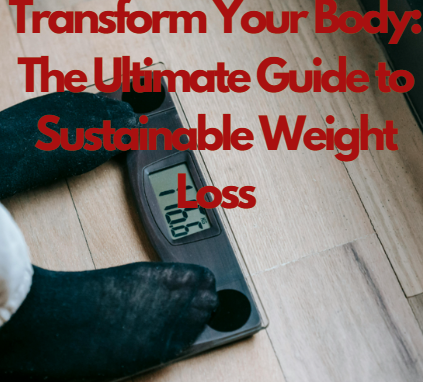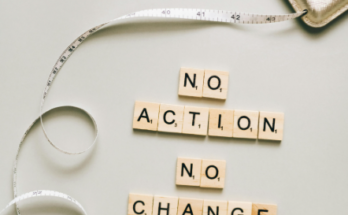Sustainable weight loss isn’t about fads, starvation diets, or endless hours in the gym. It’s about making smart, realistic changes that fit your lifestyle and stick for the long haul. If you’ve tried everything and nothing has worked, it’s time to shift your approach.
In this ultimate guide, we’ll break down the science, habits, and mindset shifts needed to transform your body—and keep it that way. Whether you’re a beginner or restarting your journey, this comprehensive article is your roadmap to lasting results.
Why Sustainable Weight Loss Matters?
Crash diets and extreme workouts might deliver quick results, but they often come at a cost:
- Muscle loss
- Slowed metabolism
- Rebound weight gain
- Mental and emotional exhaustion
Sustainable weight loss, on the other hand, is about:
- Fat loss, not just weight loss
- Maintaining muscle mass
- Building habits you can keep for life
- Supporting overall health and well-being
If you want long-term success, it’s time to ditch the “quick fix” mindset and embrace a strategic, sustainable approach.
1. Set Realistic and Meaningful Goals
Forget “I want to lose 20 pounds.” Start with goals that reflect the why behind your weight loss. Is it to feel more confident? Play with your kids without getting winded? Reverse a health condition?
Then, break that goal into smaller, actionable steps:
- Lose 1–2 lbs per week
- Walk 8,000 steps a day
- Strength train 3 times a week
- Cook 5 homemade meals weekly
Tracking small wins builds momentum—and momentum builds success.
2. Understand Your Caloric Needs
To lose fat, you need to be in a calorie deficit, meaning you consume fewer calories than you burn. But too big of a deficit can backfire, slowing your metabolism and increasing hunger.
Use a TDEE calculator to estimate how many calories your body needs to maintain its weight. Then, reduce your intake by 10–20% for gradual, sustainable weight loss.
Pro tip: Avoid obsessively counting calories. Instead, focus on food quality and portion control.
3. Focus on Nutrient-Dense Whole Foods
The key to feeling full and energized while in a calorie deficit? Eating nutrient-rich foods that support your metabolism and curb cravings.
Here’s what to prioritize:
- Lean proteins: chicken, turkey, eggs, tofu, Greek yogurt
- Healthy fats: avocado, nuts, seeds, olive oil
- Complex carbs: oats, sweet potatoes, quinoa, brown rice
- Fiber-rich veggies: broccoli, spinach, carrots, kale
- Hydration: aim for 2–3 liters of water per day
Build meals with a balance of protein, healthy fat, fiber, and complex carbs for long-lasting fullness.
4. Build a Workout Routine You Enjoy
Exercise isn’t just about burning calories—it’s about building strength, boosting mood, improving energy, and preserving muscle during fat loss.
Create a workout plan that includes:
- Strength training 2–4 times per week
- Cardio (walking, cycling, swimming) 2–3 times per week
- Mobility and stretching to support recovery
Don’t like the gym? No problem. Try bodyweight workouts, resistance bands, dance classes, or outdoor hikes. The best workout is the one you’ll stick to.
5. Prioritize Sleep and Recovery
Sleep deprivation increases hunger hormones (ghrelin), decreases fullness hormones (leptin), and raises cortisol—all of which sabotage fat loss.
Aim for:
- 7–9 hours of quality sleep per night
- A regular sleep schedule (even on weekends)
- Reducing screen time before bed
- Creating a cool, dark, and quiet sleep environment
Also, don’t underestimate rest days. Overtraining can lead to burnout and injury, derailing your progress.
6. Manage Stress Effectively
Chronic stress elevates cortisol, which can:
- Promote fat storage (especially belly fat)
- Increase cravings
- Disrupt sleep
- Lower motivation
Stress management is just as important as diet and exercise. Try:
- Meditation or deep breathing
- Journaling or gratitude practice
- Gentle movement like yoga or walking
- Taking breaks and setting boundaries
A calm mind supports a healthy body.
7. Build Habits, Not Willpower
Relying on motivation and willpower is unreliable. Instead, design your environment and routines to make healthy choices easier.
Examples:
- Meal prep once a week to avoid fast food
- Keep healthy snacks visible
- Put your gym shoes by the door
- Track your habits with a checklist or app
Small, consistent actions create momentum and identity change. You’ll become the kind of person who just does it, no mental battle required.
8. Stay Accountable
Accountability improves success. Options include:
- Joining a fitness group or challenge
- Working with a coach or trainer
- Sharing goals with a friend or partner
- Posting your progress on social media
Regular check-ins help you stay on track, troubleshoot obstacles, and celebrate progress.
9. Be Flexible, Not Perfect
There’s no “perfect” diet or routine. Life will happen. You’ll eat cake at a birthday party or miss a workout when you’re sick—and that’s okay.
The key is to:
- Get back on track quickly
- Avoid all-or-nothing thinking
- Learn from slip-ups instead of quitting
Flexibility leads to consistency—and consistency leads to results.
10. Track More Than the Scale
Weight is just one metric—and not always the best. The scale doesn’t show fat loss, muscle gain, or water fluctuations. Instead, measure your success in multiple ways:
- Progress photos
- Clothing fit
- Body measurements
- Energy and mood
- Strength and endurance
- Blood markers and health indicators
Focus on the big picture, not just the number.
Conclusion: Sustainable Weight Loss is a Lifestyle
Transforming your body isn’t about punishment—it’s about empowerment. It’s about treating your body with respect, making intentional choices, and creating habits that support your health long-term.
With the right mindset, tools, and support, you can build a lifestyle that not only transforms your body but enhances every part of your life.
FAQs
1. How long does sustainable weight loss take?
Expect to lose 1–2 pounds per week. Slower progress may be more sustainable and lead to better long-term results.
2. What’s better for fat loss—cardio or weights?
Both matter, but strength training is essential for maintaining muscle and boosting metabolism.
3. Can I eat carbs and still lose weight?
Yes! Focus on whole, fiber-rich carbs like oats, fruits, and vegetables—just watch portion sizes.
4. What if I hit a plateau?
Review your food intake, increase NEAT (daily movement), switch up your workouts, or reduce stress. Plateaus are normal and temporary.
5. Do I need supplements to lose weight?
Not necessarily. Focus on food first. Some may benefit from protein powder, omega-3s, or vitamin D, but consult a healthcare provider.




